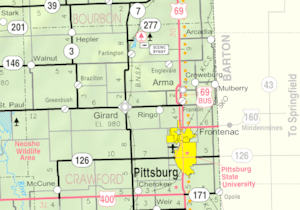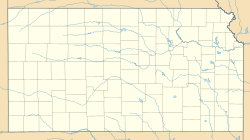Yale, Kansas facts for kids
Quick facts for kids
Yale, Kansas
|
|
|---|---|

|
|
| Country | United States |
| State | Kansas |
| County | Crawford |
| Elevation | 958 ft (292 m) |
| Population
(2020)
|
|
| • Total | 81 |
| Time zone | UTC-6 (CST) |
| • Summer (DST) | UTC-5 (CDT) |
| Area code | 620 |
| FIPS code | 20-80650 |
| GNIS ID | 2806588 |
Yale is a small community in Crawford County, Kansas, United States. It is called a census-designated place (CDP) because it's a special area defined for gathering population data. In 2020, 81 people lived there.
Yale is located northeast of Frontenac. You can find it where E 600th Ave and S 250th St meet. It's also about one mile west of the Missouri state border. The community is famous for its local restaurants, Chicken Mary's and Chicken Annie's.
Contents
Discovering Yale's Past
Yale started as a town for miners. It was built along the Missouri Pacific Railroad. The Western Coal and Mining Company founded Yale in 1890. It was mainly a mining camp for African American workers until 1930.
Mining Strikes and New Workers
In the 1890s, Yale was part of two big mining strikes. These happened in 1893 and again in 1899. During these strikes, many non-union African American miners came to the area to work in the mines. They were recruited from Alabama to help with labor during the strikes.
In 1893, about 375 African American miners moved to Yale. In 1899, another 175 African American miners arrived. The Western Coal Mining Company brought these workers to Yale using the Missouri Pacific Railroad. In 1899, the new miners were taken to a special building called a stockade. This was to keep them safe from the white striking miners who were not happy about their arrival. Even after the second strike ended in September 1899, coal companies kept hiring African American miners.
Life in Early Yale
By 1900, Yale had grown into a busy town. It had its own post office, stores, schools, and churches. There was also a doctor and many homes for the miners and their families. The post office in Yale opened in 1892 and stayed open until 1914.
When new African American miners arrived, some had to live in a skating rink that was turned into a boarding house. In 1900, a group called the "Big Colored Band from Yale" played music for President Theodore Roosevelt when he visited Pittsburg, Kansas. Also, in February and March of that year, there were two small outbreaks of smallpox.
Changes and Moving Away
Because many African American people moved to the area, some tensions grew. A local burial ground, now known as the Yale African American Cemetery, is located north of Mindenmines, in Barton County, MO. It is believed that 248 people are buried there.
By the early 1930s, many African American residents had moved away from Yale. They became part of a big movement called the Great Migration. They often moved north to places like the Kansas City area, looking for new opportunities.
Population Facts
| Historical population | |||
|---|---|---|---|
| Census | Pop. | %± | |
| 2020 | 81 | — | |
| U.S. Decennial Census | |||



